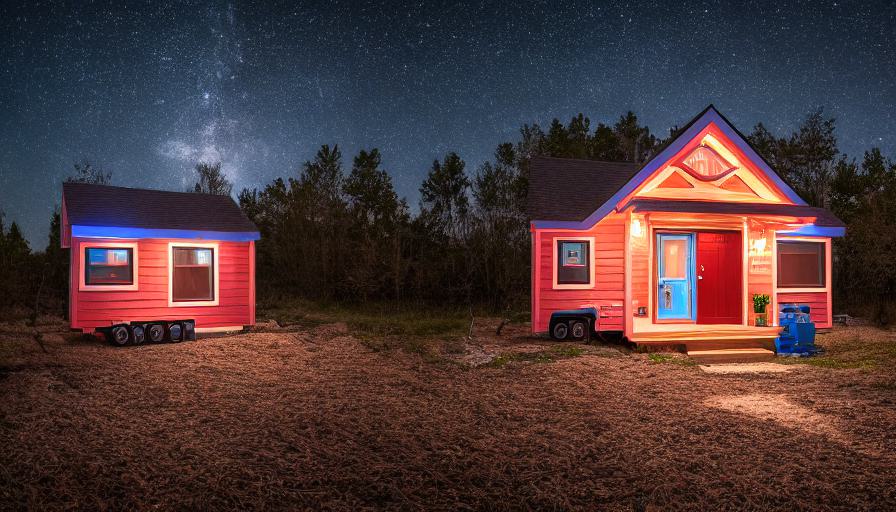Table of Contents
- Introduction
- Monochromatic Color Scheme
- Definition of Monochromatic Color Scheme
- Benefits of Using a Monochromatic Color Scheme for Tiny Homes
- Examples of Successful Monochromatic Color Schemes in Tiny Homes
Introduction
Tiny homes are becoming increasingly popular due to their affordability and low environmental impact. However, since they are small in size, it can be difficult to create an inviting atmosphere within a tiny home. Fortunately, color psychology can be used to create the perfect atmosphere for a tiny home. This article will discuss the impact of color on tiny homes and how to use color psychology to create an inviting atmosphere in a small space. It will suggest using a monochromatic, analogous, or complementary color scheme, as well as strategically-placed mirrors or light fixtures to make a tiny home feel more spacious. Examples of successful color schemes for different styles of tiny homes will also be provided, such as minimal palettes for calming atmospheres, bright hues for energizing atmospheres, and warm and cool colors with pops of bright hues for a more eclectic look. Lastly, the importance of balancing bold and neutral colors in order to create a calming and cohesive atmosphere will be emphasized.
Monochromatic Color Scheme
A monochromatic color scheme is a great choice for tiny homes because it creates a calming atmosphere and can make a small space look larger. A monochromatic color scheme is composed of various shades, tints, and tones of one hue. For example, you could use different shades of blue to create a monochromatic color palette in your tiny home.
Definition of Monochromatic Color Scheme
The term “monochromatic” means “one color” or “of one color”. A monochromatic color scheme uses variations of one hue to create a cohesive look. This type of color scheme can be achieved by using different shades, tints, and tones of the same hue. For example, you could use light blue, navy blue, and royal blue to create a monochromatic palette in your tiny home.
Benefits of Using a Monochromatic Color Scheme for Tiny Homes
Using a monochromatic color scheme for your tiny home has many benefits. It creates a calming atmosphere which can help to reduce stress levels in the space and make it feel more spacious. The subtle variations between the different shades can also add depth and texture to the room without adding too much visual clutter. Additionally, this type of color scheme is easy to match with other colors if you want to add some accent pieces or accessories to the room without clashing with the existing colors.
Examples of Successful Monochromatic Color Schemes in Tiny Homes
There are many successful examples of monochromatic color schemes that have been used in tiny homes all over the world. One popular example is using shades of gray for an overall calming effect on the space while still having enough variation between the different colors to keep it interesting. Another example is using shades of pink or purple for an energizing atmosphere that is still calming at the same time. Finally, white walls paired with dark wood accents can create a classic yet modern look that will stand out from traditional tiny homes while still feeling cozy and inviting.
Analogous Color Scheme
An analogous color scheme is a type of color palette that uses colors that are adjacent to each other on the color wheel. This type of color scheme has the potential to create a harmonious and calming atmosphere in a tiny home, making it an ideal choice for those who want to create a peaceful and inviting atmosphere.
Definition of Analogous Color Scheme
An analogous color scheme is created by using colors that are adjacent to one another on the color wheel, such as green and blue or red and orange. These colors are often referred to as “harmonizing” because they blend together well and create a sense of unity in a space. This type of color scheme can be used to create an inviting atmosphere in small spaces, as it creates a sense of balance without being too overwhelming or busy.
Benefits of Using an Analogous Color Scheme for Tiny Homes
Using an analogous color scheme in a tiny home can help to create a calming atmosphere, as the colors blend together seamlessly and provide visual interest without being too overpowering. Additionally, this type of color scheme can help to make a tiny home feel larger than it actually is, as the colors tend to draw attention away from any tight corners or small spaces that may exist.
Examples of Successful Analogous Color Schemes in Tiny Homes
There are many successful examples of analogous color schemes being used in tiny homes. For example, if you are looking for a calming atmosphere, you could use shades of blue and green throughout your tiny home, with pops of yellow or orange for contrast. If you prefer something more energizing, you could use shades of red and orange with accents of yellow or purple for contrast. Finally, if you want something more eclectic, you could mix warm and cool tones with pops of bright hues like yellow or pink throughout your space for added interest.
No matter what style you choose, it is important to remember that using an analogous color scheme doesn’t mean that your space needs to look monotonous – adding texture through fabrics or furniture pieces can add visual interest while still keeping with the overall theme of your space. Additionally, strategically placed mirrors or light fixtures can help to make your tiny home feel bigger by reflecting light around the room and creating the illusion of more space.
In conclusion, using an analogous color scheme in your tiny home can help to create an inviting atmosphere that is both calming and visually appealing. By combining different shades within the same family and strategically placing mirrors or light fixtures throughout the space, you can make your tiny home feel larger than it actually is while still creating an aesthetically pleasing environment for yourself and others who may visit your home.
Analogous color schemes create a harmonious and calming atmosphere in tiny homes, making it an ideal choice for those who want a peaceful, inviting atmosphere. Combining different shades within the same family and strategically placing mirrors or light fixtures can make tiny homes appear larger.
Complementary Color Scheme
A complementary color scheme is one of the most popular choices for tiny homes due to its ability to create a visually pleasing and inviting atmosphere. This type of color scheme is composed of two colors that are directly opposite each other on the color wheel, such as blue and orange, purple and yellow, or red and green. By combining these two colors, it creates a look that is both eye-catching and balanced.
Definition of Complementary Color Scheme
A complementary color scheme is a combination of two colors that are directly opposite each other on the color wheel. These colors can be used in different proportions to create an aesthetically pleasing effect. For example, if you were to use blue and orange as your main colors in a tiny home, you could use more blue in certain areas and more orange in others to create a unique visual balance.
Benefits of Using a Complementary Color Scheme for Tiny Homes
Using a complementary color scheme in your tiny home can have several benefits. First, it will create an eye-catching look that will draw attention to certain features of the space. Second, it will help to make the space appear larger by creating contrast between light and dark colors. Finally, it can also be used to create interesting focal points within the space by playing with proportions of the two colors.
Examples of Successful Complementary Color Schemes in Tiny Homes
One example of a successful complementary color scheme for a tiny home would be using shades of pink and green together throughout the space. This combination creates an inviting atmosphere while still being bright and cheerful enough to keep the room feeling open and airy. Another great example would be using shades of navy blue and yellow together throughout the space; this will give the room an elegant yet modern feel while still keeping it light and airy with its contrasting hues. Finally, you could also opt for shades of grey and orange; this combination will give off a warm yet sophisticated vibe that is perfect for any style of tiny home!
|
Color Scheme
|
Definition
|
Benefits
|
Examples
|
|
Complementary
|
Two colors directly opposite each other on the color wheel. Can create interesting focal points by playing with proportions.
|
Eye-catching, creates contrast between light and dark colors, can make the space appear larger.
|
Pink & Green, Navy Blue & Yellow, Grey & Orange.
|
Balance Bold and Neutral Colors in a Tiny Home
Using bold colors in a tiny home can be a great way to add personality and vibrancy to the space, but it is important to balance these colors with neutral tones in order to create a calming and cohesive atmosphere. To achieve this balance, consider using light neutrals such as white, cream, or gray as the base color for the walls and then adding pops of bolder colors in furniture, accessories, artwork, and textiles. This will create an inviting atmosphere without overwhelming the small space.
Benefits of Balancing Bold and Neutral Colors in a Tiny Home
Balancing bold and neutral colors is key when decorating a tiny home because it allows you to create an inviting atmosphere without overwhelming the small space. The neutral tones provide a calming backdrop while the pops of bold color add energy and interest to the room. This balance also helps to make the room feel more spacious by creating visual flow between different areas of the home.
Examples of Balanced Colors in a Tiny Home
For example, if you are looking for an energizing atmosphere in your tiny home, consider painting the walls white or light gray and adding bright yellow accents. Or if you prefer a calming atmosphere, use soft blues on the walls with pops of green or pink accents throughout. You can also create an eclectic look by combining warm and cool colors with pops of bright hues like orange or purple. No matter which color scheme you choose, make sure to balance bold and neutral colors for an inviting atmosphere that won’t overwhelm your tiny home.
The use of color in a tiny home can have a profound impact on the atmosphere and feel of the space. By understanding the basics of color psychology, it is possible to choose a paint scheme that will create an inviting atmosphere in a small space. Monochromatic, analogous, and complementary color schemes are all great options for tiny homes, as well as strategically-placed mirrors or light fixtures to make the space appear more spacious. Examples of successful color schemes for different styles of tiny homes include minimal palettes for calming atmospheres, bright hues for energizing atmospheres, and warm and cool colors with pops of bright hues for a more eclectic look.
Ultimately, it is important to remember to balance bold and neutral colors in order to create a calming and cohesive atmosphere. This can be achieved by utilizing both light and dark shades in the same room to provide visual interest while still maintaining a sense of harmony. With careful consideration, anyone can use color psychology to create an inviting atmosphere in their tiny home that reflects their unique style.


